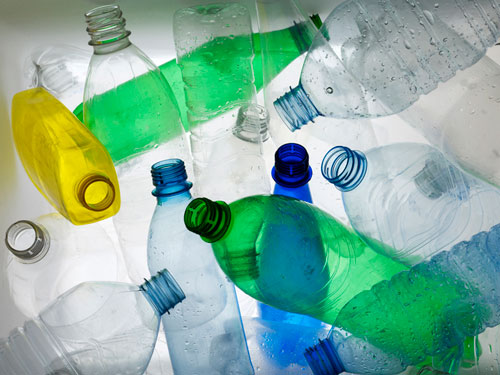For years, we were told that BPA (bisphenol A) was the harmful ingredient in plastic bottles.
BPA and its chemical cousins, BPS (bisphenol S) and BPF (bisphenol F), are linked to cancer, heart disease, diabetes, hormone problems, and migraines.[1]
Get rid of BPA, and plastic food and beverage containers would be perfectly safe, the plastics industry and the FDA said.
So in 2012, the FDA banned BPA from baby bottles and sippy cups. And the plastics industry started removing the chemical from other products as well.[2]
Plastics companies turned lemon into lemonade. They used the situation as a marketing opportunity. They started substituting another chemical for BPA, and touted their products as “BPA-free.”
This created a wave of new demand and profit as people rushed to replace their BPA-tainted water bottles.
Now, a recent study has found that the new chemical—PET (polyethylene terephthalate)—may be just as dangerous as BPA.
Researchers from Goethe University in Frankfurt analyzed 20 brands of water. Nine used glass bottles, nine used PET plastic bottles, and two used juice-like boxes with linings that contained PET.[3]
They added a specialized type of yeast to water from each container. It was genetically engineered to change color in reaction to estrogen-like compounds.
Estrogen is the primary female sex hormone. It’s responsible for developing and maintaining feminine sex characteristics. Exposure to excess estrogen in men leads to weight gain, ED, depression, and fatigue. In women, it can cause PMS symptoms, bloating, and insomnia.[4] [5]
The yeast changed color in samples from seven of the nine PET-based plastic bottles and both plastic-lined boxes.
Scientist: ‘This Study Made Me Give Up Bottled Water’
Dr. Martin Wagner was the lead researcher. He described the estrogenic compound levels as surprisingly high.
“If you drink water from plastic bottles, you have a high probability” of consuming PET chemicals, said Dr. Wagner.
The scientists also tested the hormonal effects of the containers on snails. When female snails are exposed to estrogen, they produce an abnormally high number of offspring.
After eight weeks of being kept in PET containers, the snails had twice as many embryos as those kept in glass bottles.
“Having done all these experiments, I started drinking tap water,” said Dr. Wagner. “It might have other stuff in it, but at least it doesn’t have estrogenic compounds.”
The bottom line?
Avoid using plastic bottles or food containers of any kind. And never reuse disposable water bottles.
When you handle the bottle, you naturally bend and flex the plastic. This causes PET to be released.
Never drink from bottled water that is past its expiration date or has been stored in high temperatures. The heat will cause chemicals to leach out even more than usual.[6]
Use stainless steel or glass water containers. And fill them using filtered tap water.
Avoid canned foods. Can linings often contain BPA or PET.
Plastic is everywhere. It’s impossible to avoid it entirely. But do your health a favor and minimize how much goes into your body.
Editor’s Note: If you’re concerned about exposure to the toxic chemicals that are all around us, you need the Toxin Flush Protocol. It’s a detailed plan to help remove toxins from your system. You can get it in our monthly journal, Independent Healing. It’s your best source for evidence-based health advice. Go HERE to subscribe.
Related Articles
Beware of Toxic ‘Quats’ in Personal Care Products
When You Eat at a Restaurant, You Go Home With Plastic in Your Body
7 Things You
Should Throw Away Immediately
Like this Article? Forward this article here or Share on Facebook.
[1]https://www.thehealthy.com/hydration/never-refill-plastic-water-bottles/
[2] https://en.wikipedia.org/wiki/BPA_controversy
[3]https://www.abc.net.au/science/articles/2009/04/29/2555698.htm
[4]https://www.lifeextension.com/Magazine/2008/11/Dangers-of-Excess-Estrogen-in-the-Aging-Male/Page-02
[5] https://www.medicalnewstoday.com/articles/323280.php
[6]https://orbmedia.org/sites/default/files/FinalBottledWaterReport.pdf

